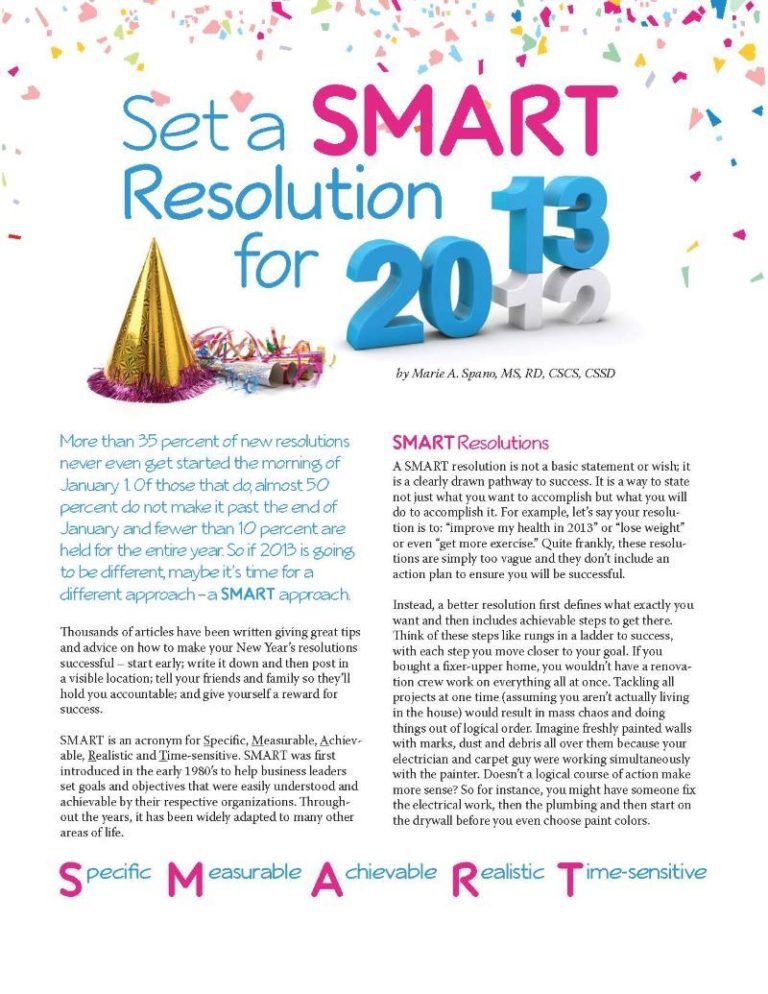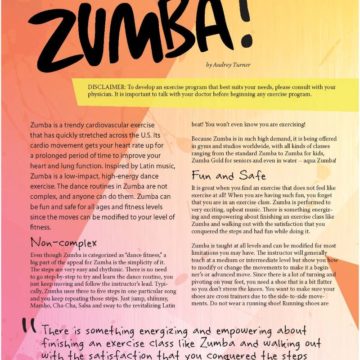Set a SMART Resolution for 2013


by Marie A. Spano, MS, RD, CSCS, CSSD
Winter 2013
More than 35 percent of new resolutions never even get started the morning of January 1. Of those that do, almost 50 percent do not make it past the end of January and fewer than 10 percent are held for the entire year. So if 2013 is going to be different, maybe it’s time for a different approach – a SMART approach.
Thousands of articles have been written giving great tips and advice on how to make your New Year’s resolutions successful – start early; write it down and then post in a visible location; tell your friends and family so they’ll hold you accountable; and give yourself a reward for success.
SMART is an acronym for Specific, Measurable, Achievable, Realistic and Time-sensitive. SMART was first introduced in the early 1980’s to help business leaders set goals and objectives that were easily understood and achievable by their respective organizations. Throughout the years, it has been widely adapted to many other areas of life.
SMART Resolutions
A SMART resolution is not a basic statement or wish; it is a clearly drawn pathway to success. It is a way to state not just what you want to accomplish but what you will do to accomplish it. For example, let’s say your resolution is to: “improve my health in 2013” or “lose weight” or even “get more exercise.” Quite frankly, these resolutions are simply too vague and they don’t include an action plan to ensure you will be successful.
Instead, a better resolution first defines what exactly you want and then includes achievable steps to get there. Think of these steps like rungs in a ladder to success, with each step you move closer to your goal. If you bought a fixer-upper home, you wouldn’t have a renovation crew work on everything all at once. Tackling all projects at one time (assuming you aren’t actually living in the house) would result in mass chaos and doing things out of logical order. Imagine freshly painted walls with marks, dust and debris all over them because your electrician and carpet guy were working simultaneously with the painter. Doesn’t a logical course of action make more sense? So for instance, you might have someone fix the electrical work, then the plumbing and then start on the drywall before you even choose paint colors.
Tackle life the same way you would tackle that house. Instead of saying you will improve your health, first define what that means to you.
- Lowering your blood pressure to within normal limits?
- Getting your regular yearly health exam and then figuring out if you have any nutrient gaps that you need to address?
- Losing weight until you hit a healthy weight range?
- Exercising at least three times per week for 30 minutes or more per session?
Specific Goals
Clearly define your goal. Make it as Specific as possible. And write down exactly why you want to achieve this goal. Without at least one good, well-thought-out reason, your goal is meaningless to your life. As an example, “Jan” decided to join a weight-loss program, but when asked why she wanted to lose weight, she couldn’t come up with a reason. And she didn’t know what was motivating her.
Consequently, her weight went up and down throughout the 12-week program and at the end she felt like she should have done better and lost more weight. This was the perfect opportunity for a reality check. With no clear-cut motivation or reason why she was trying to lose weight, she was wasting her time. And then, she finally came up with something – feeling better (tough to measure), healthy numbers (body mass index) and cute clothes. So for every 10 pound weight-loss that she hit, she treated herself to a trip to the mall.
Knowing why you are doing something adds value, makes getting up at 5:30 am to fit exercise into your schedule worthwhile and gives you a reason to say no to that double fudge brownie ice cream sundae.
Measurable Goals
Next, make your goal Measurable. Weight-loss, painted walls and healthy blood pressure are all very measurable. But, what about moving up at work? Does that mean a raise and if so, how much? Or does it mean better projects, travel and a new title? Whatever you want to achieve, sit back and think about it and make sure you have some way of measuring when you meet your goal (as well as each step on the way there).
Timestamp Goals
After these first two steps, it is time to put a timestamp on achieving your goal or at least the first several steps. Time-sensitive goals are more likely to be achieved whereas a loose thought such as, “Someday I want to finish my college degree,” will get piled behind a to-do list that keeps on growing.
Realistic and Achievable Goals
Also, be Realistic and ask yourself if your goal is achievable in the allotted time? Consider padding your timeline to account for the unexpected. Sick kids, a wedding you have to fly across the country for, whatever it is, life happens. And if your time line is unrealistic to begin with and then you end up taking a detour or hit a temporary stoplight, you’ll feel like a failure and give up.
Now, if you think this process takes time, you are right. But putting yourself on your agenda without any interruptions is the best way to move forward with your goals. If you don’t do this, you are living a reactive life – reacting to what is thrown your way versus a proactive life – one that you create and one that includes what you want, not just what others want from you.
Getting Your Head in the Game
After you take the time to set your SMART goals for the New Year, you may wonder what comes next, do you just get started? Well, there is one last thing you should assess: Where your head is.
Surely you’ve heard the common phrase, “If you believe, you can achieve.” Believing you can do something is half the battle. In fact, experts have found a common trait among people who are successful at overcoming addictions (one of the toughest things a person can tackle):
They believe they can do it and believe in the people from whom they enlist help (counselors, etc.).
If this is the toughest part for you, start with what you verbalize.
Many people beat themselves up or make excuses in front of others. Statements such as, “Gosh, my hips are way bigger than yours,” or “Yes, I just can’t seem to get rid of this gut,” impede your progress. In fact, by saying these out loud, you are telling yourself where you will end up. So first, keep your mouth shut unless it is positive. If someone compliments you, say “thank you” and move on. If they put you down, walk away.
Focus on Positivity
Once you stop verbalizing negativity out loud, it’s time to retrain your brain and quit thinking negative thoughts as well. So for instance, if you want to lose weight and your mind fixates on “Gosh, I’ve been fat since I was a kid” or “I am over 50, so I know this is going to be hard,” stop immediately and do whatever it takes to focus on something else. This takes practice, but you can think of lying on the beach, fond memories of your trip to the coast of Italy or playing with one of your kids, grand-kids or nephews. Take yourself and your mind to your happy place. Slowly start to change those thoughts to “I can do this,” and “I know I will lose X pounds by X date.” If you don’t believe it, think of your best friend, your cheerleader in this process and what they would say to you. Sometimes you do have to fake it till you make it, but the goal is to believe in yourself and trust yourself to make good decisions.
Conclusion
Once you make your SMART goals and believe you can achieve them, make a commitment to yourself. Commit to living a better life, being who you are and doing what you want to do. After all, you are responsible for one main thing, your own happiness. Why not start today and figure out how to get there?
About the Author:
Marie A. Spano, MS, RD, CSCS, CSSD, is a nutrition communications expert and one of the country’s leading sports nutritionists. Ms. Spano has appeared on NBC, ABC, Fox and CBS affiliates, and authored hundreds of magazine and trade publication articles, book chapters, marketing materials and web copy on a variety of nutrition topics. She is co-editor of the National Strength and Conditioning Association’s Guide to Exercise and Sport Nutrition (Human Kinetics Publishers) and currently working on a second book.
by Robyn Pashby, PhD Winter 2024 “No one is ever going to date you if you don’t…
Read Articleby Rachel Goldman, PhD, FTOS; Sarah Muntel, RD; and Stefanie Trilling Winter 2024 This section of Weight…
Read Articleby Nina Crowley, PhD, RD (with Inspiration from Shawn Cochran) Winter 2024 Dating, no matter your age,…
Read Article









